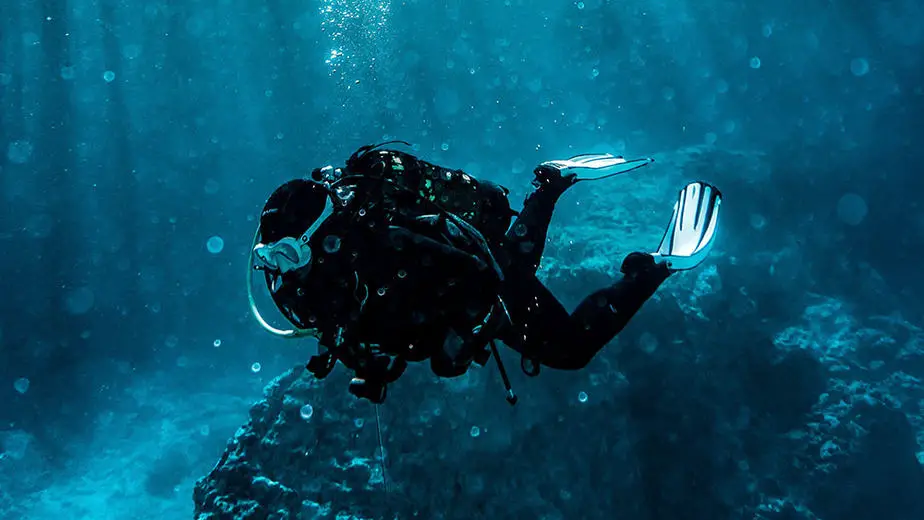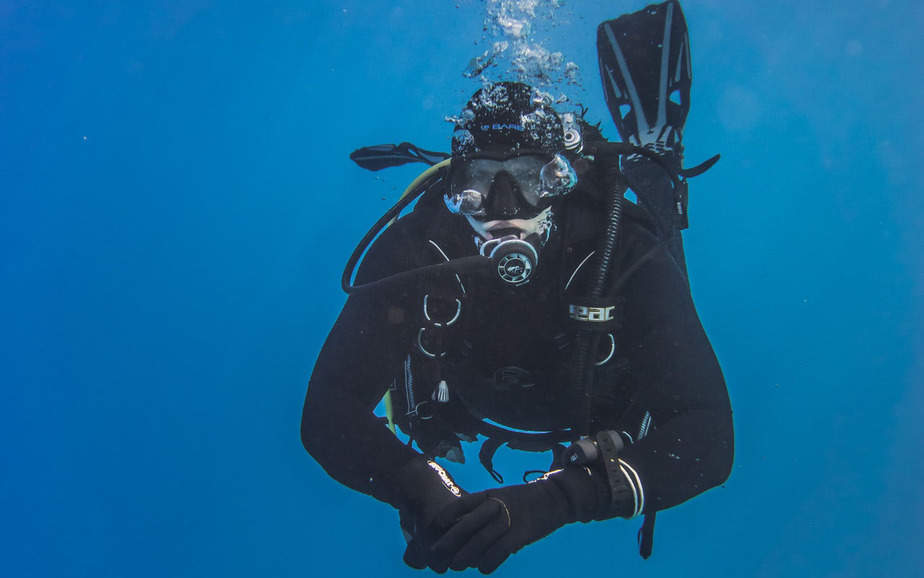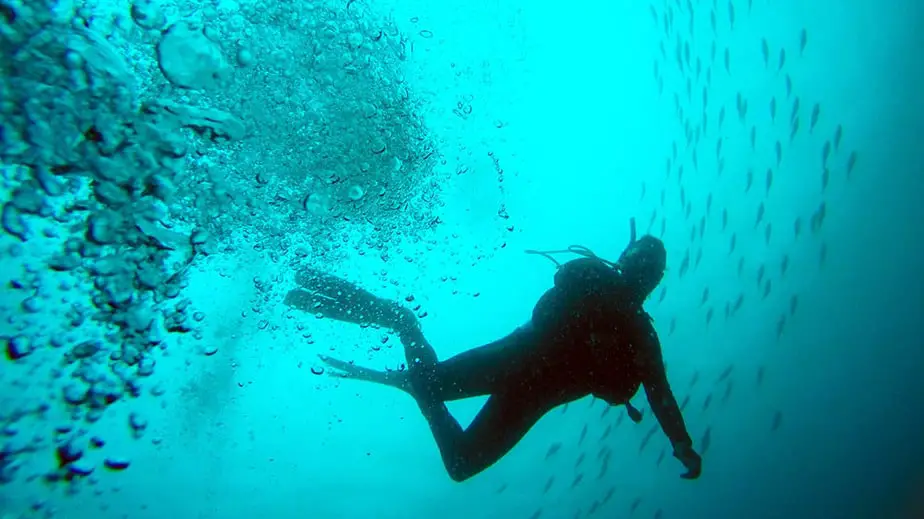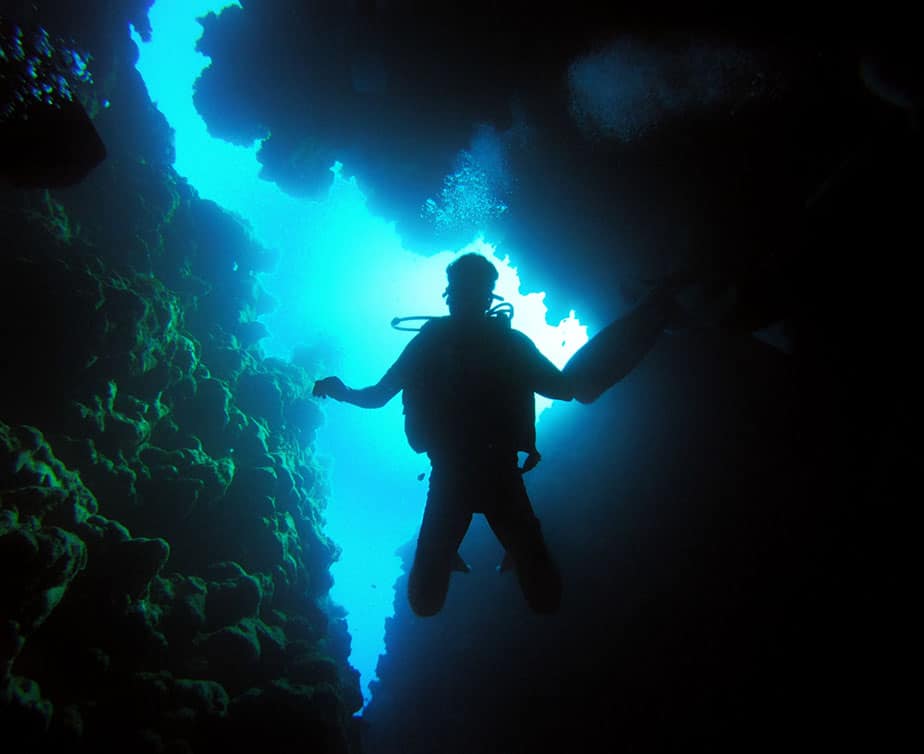One of the first things you’ll learn in a scuba diving course is how breathing compressed air puts you at increased risk of experiencing decompression sickness. To mitigate this, divers are instructed to perform a series of decompression stops as they ascend, with a final safety stop just before reaching the surface. If you dive only in shallow waters without exceeding your no-stop decompression limit (NDL), theoretically you don’t have to perform any decompression stops.
So how deep can you dive without decompression stops? Here are a couple of examples: a diver at 35 feet (10.7 meters) can spend 205 minutes underwater without needing to perform a decompression stop. A diver at 140 feet (42.7 meters) can only remain there for 9 minutes before they are required to perform a mandatory decompression stop for a safe ascent. This information can be found by looking at the PADI dive table planner or a similar dive table from another scuba certification agency.
Nowadays, divers use a dive computer to perform all of the decompression calculations for them. Instead of looking at a dive planner, a dive computer will tell you exactly what your NDL is. If you exceed it, your dive computer will also let you know when you should perform a decompression stop and for how long.
Even though dive computers take care of almost everything nowadays, it’s still a good idea to understand the underlying reasons for why decompression stops need to be done. In this article, we’ll go over the factors that affect your NDL, what to do if you exceed your NDL, and how you can avoid decompression sickness for safer dives.
PADI Dive Table Planner No-Decompression Limits
If you found PADI’s dive table planner a bit difficult to read, here is a simplified table for your viewing pleasure.
| Depth | No-Decompression Limit |
| 35 ft (10.67 m) | 205 minutes |
| 40 ft (12.19 m) | 140 minutes |
| 50 ft (15.24 m) | 80 minutes |
| 60 ft (18.29 m) | 55 minutes |
| 70 ft (21.34 m) | 40 minutes |
| 80 ft (24.38 m) | 30 minutes |
| 90 ft (27.43 m) | 25 minutes |
| 100 ft (30.48 m) | 20 minutes |
| 110 ft (33.53 m) | 16 minutes |
| 120 ft (36.58 m) | 13 minutes |
| 130 ft (39.62 m) | 10 minutes |
| 140 ft (42.67 m) | 8 minutes |
As you can see, the deeper you dive, the shorter your no-decompression limit at that depth is. The reason for this is that the water pressure is greater the deeper you go. As the pressure increases, you will inhale a large quantity of air and nitrogen.
The nitrogen will linger in your blood and tissues for a long time, and you will need to properly decompress by performing decompression stops if you exceed the NDL. Even if your dive does not require any decompression stops, that doesn’t mean you can throw caution to the wind.
What is decompression diving?

Each time you scuba dive, you will be subject to water pressure and breathe compressed air. The deeper you dive and the longer your bottom time, the more nitrogen in the compressed air will enter your bloodstream and tissues. This is known as on-gassing, and after a certain point you will be required to perform a decompression stop to allow nitrogen to safely release.
The exact point in which you have to perform a decompression stop is indicated by your no-decompression limit. To put it simply, the NDL is the calculation of how much time you can spend at a specific depth from where you can ascend without performing any decompression stops.
Thus, a decompression dive is one where you exceed your NDL and are required to perform decompression stops on your ascent. Once your NDL has been exceeded, it’s no longer enough to ascend slowly at a rate of 9 meters (30 feet) per minute; you’ll still have too much nitrogen in your body.
If you lose track of time while diving and exceed your NDL, your dive has turned into a decompression dive and you will need to perform an emergency stop during the ascent. All deep sea dives require significant decompression.
Every dive is a decompression dive
Divers need to realize that even shallow, recreational dives will cause nitrogen to enter the body’s tissues and bloodstream. It may not be enough to warrant a deco stop, but it’s enough of a risk that one should always maintain a slow, safe ascent rate and make a safety stop at the end of each dive.
You may have personally experienced or witnessed some going through an “undeserved” decompression sickness. That is, a seemingly unexplained sickness that occurs to a diver that followed the decompression guidelines to a “T”. This is because violating the ascent rate and safety stop guidelines, even on dives that do not warrant a deco stop, is a risk.
Even though these “undeserved” cases of decompression sickness are very rare in recreational diving, they can and do happen. For this reason, it’s highly recommended that divers treat each dive like it’s a decompression dive. Because even in shallow dives, nitrogen will enter your system, and that means the risk of decompression sickness is always there.
What is a decompression stop?

At certain points during the ascent as calculated by your dive table or dive computer, you will have to perform decompression stops to grant enough time for the nitrogen in your body to release to safer levels. Decompression stops are a mandatory part of the off-gassing process to avoid getting bent. If you miss a stop, you drastically increase your chances of getting the bends.
Decompression stops are a series of stops performed one after another, each one at a slightly higher depth than the last. After waiting for the specified time at a deco stop, the diver will move to the next stop and wait there, on and on until they eventually complete all of the stops and reach the surface.
For example, the first deco stop might be at 12 meters, the next at 9 meters, then 6 meters, and then a final safety stop at 3 meters for 3-5 minutes before reaching the surface. This process gives your body time to off-gas to avoid nitrogen-associated issues.
Multiple dives in a day and how it affects the no-decompression limit
Calculating your NDL gets trickier if you’re doing multiple dives in a day. Divers need to understand that performing a safety stop or a few decompression stops before surfacing is not enough time for the excess nitrogen in the body to be safely dissolved. Even after surfacing, there will be residual nitrogen in their body.
Thus, going for another dive in the same day has increasingly more risk because your tolerance for more compressed nitrogen is decreased, and your chances of experiencing decompression sickness is increased. In other words, your NDL for subsequent dives will be shorter than the first dive of the day due to the residual nitrogen in your system.
You can calculate your NDL using dive tables, however the dive computer can handle all of these calculations for you. Generally speaking, a diver should never exceed their NDL unless they are properly trained on how to make decompression stops.
What is the difference between a safety stop and a decompression stop?
A safety stop is a precautionary stop performed at 5-6 meters (16-20 feet) from the surface for 3-5 minutes. Safety stops are considered optional if you only performed a shallow dive that never exceeded 10 meters (30 feet). However, dives that exceed 10 meters in depth require a safety stop during the ascent.
With that said, most diving agencies recommend you perform a safety stop at any depth. Technically, at any depth your body is absorbing more nitrogen than on land. Thus, even if you do a shallow dive there is still a risk of getting decompression sickness. The thought process is, why even take that risk by skipping the safety stop? It’s up to you to decide if the risk is worth it.
Decompression stops, unlike safety stops, are absolutely mandatory once the NDL has been exceeded. Furthermore, there are usually multiple stops done at progressively higher depths instead of just one close to the surface. The final stop of a decompression dive should be the safety stop.
Emergency stop – what to do if you exceed your NDL

Should you exceed your NDL, you will need to make an emergency stop before you reach the surface.
If you exceed the NDL by less than 5 minutes, instead of your usual safety stop, perform an 8-minute emergency stop (or however long your remaining air allows for) at 5 meters (16.4 feet) below the surface. After this, wait at least 6 hours before you perform another dive or go to a higher elevation.
If you exceed the NDL by more than 5 minutes, you will have to perform a 15-minute emergency stop (or however long your remaining air allows for) at 5 meters (16.4 feet) below the surface. Afterwards, wait a minimum of 24 hours before going on the next dive or getting on an airplane.
“Undeserved” decompression sickness – followed all the guidelines and got bent anyways
Divers can get decompression sickness even if they followed all the safe diving practices: no-decompression limits, safe ascent rates, safety stops, dive tables, the whole shebang. How come? Are these guidelines ineffective?
Not so. All of these guidelines are just recommendations created after careful consideration of decades of diving data. They are based on experience, statistics, and mathematical algorithms. However, they are not some immutable laws of the universe. No guideline or algorithm can completely guarantee that a diver will be immune from decompression sickness if they follow it. Divers have different physiologies.
It’s possible, therefore, that after following best practices, a diver still has not avoided absorbing such a high quantity of nitrogen, or still not enough time has elapsed for the body to off-gas the excess nitrogen. Furthermore, divers with medical conditions may predispose them to decompression sickness. They would be wise to be even more conservative than even what the guidelines suggest.
Parting words
Asking how deep you can dive without decompression implies a desire to ascend quickly and perhaps violate the ascent rate and safety stop guidelines. Or it may just be an innocent question. Either way, it is up to each diver to take responsibility for their own safety.
It’s possible to get bent on a shallow 40-foot recreational dive. It’s also possible to get bent on a 30-foot dive. Does this mean that nobody is safe and that all divers should panic and just quit diving? No! Diving has its fair share of risks, and though some insurance companies classify it as an “extreme” sport, it has a terrific safety record and nowadays is relatively low-risk.
A wise diver who knows his limits and stays well within it can dive for decades without any incidents. Owning a dive computer to create a dive profile and track ascent rates is a good place to start. Dive computers can also account for multilevel dives, deep stops, altitudes, freshwater vs. saltwater diving, and more.
Very importantly, a dive computer will consider the residual nitrogen in the diver’s body and factor this into the NDL calculations. After a dive, there is still excess nitrogen that needs to be off-gassed. If you dived earlier in the day, the subsequent dive will have a decreased NDL.
Furthermore, a safe diver will also consider his physical state and health before diving. They will not consume alcohol before a dive, and will not dive when sick, stressed, or exhausted. A safe diver will be well-hydrated and be in a relaxed state of mind when diving.
Lastly, no matter what, a smart diver will consider each dive to be a compression dive, and will adhere to the ascent rate and safety stop guidelines on every dive, even on shallow, no-decompression dives, so that they can avoid getting bent.

